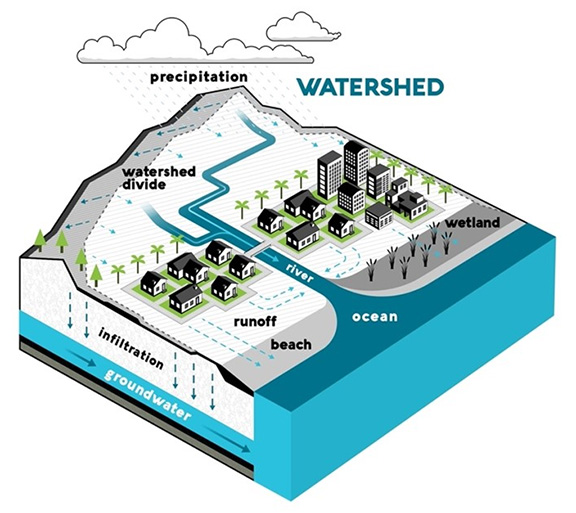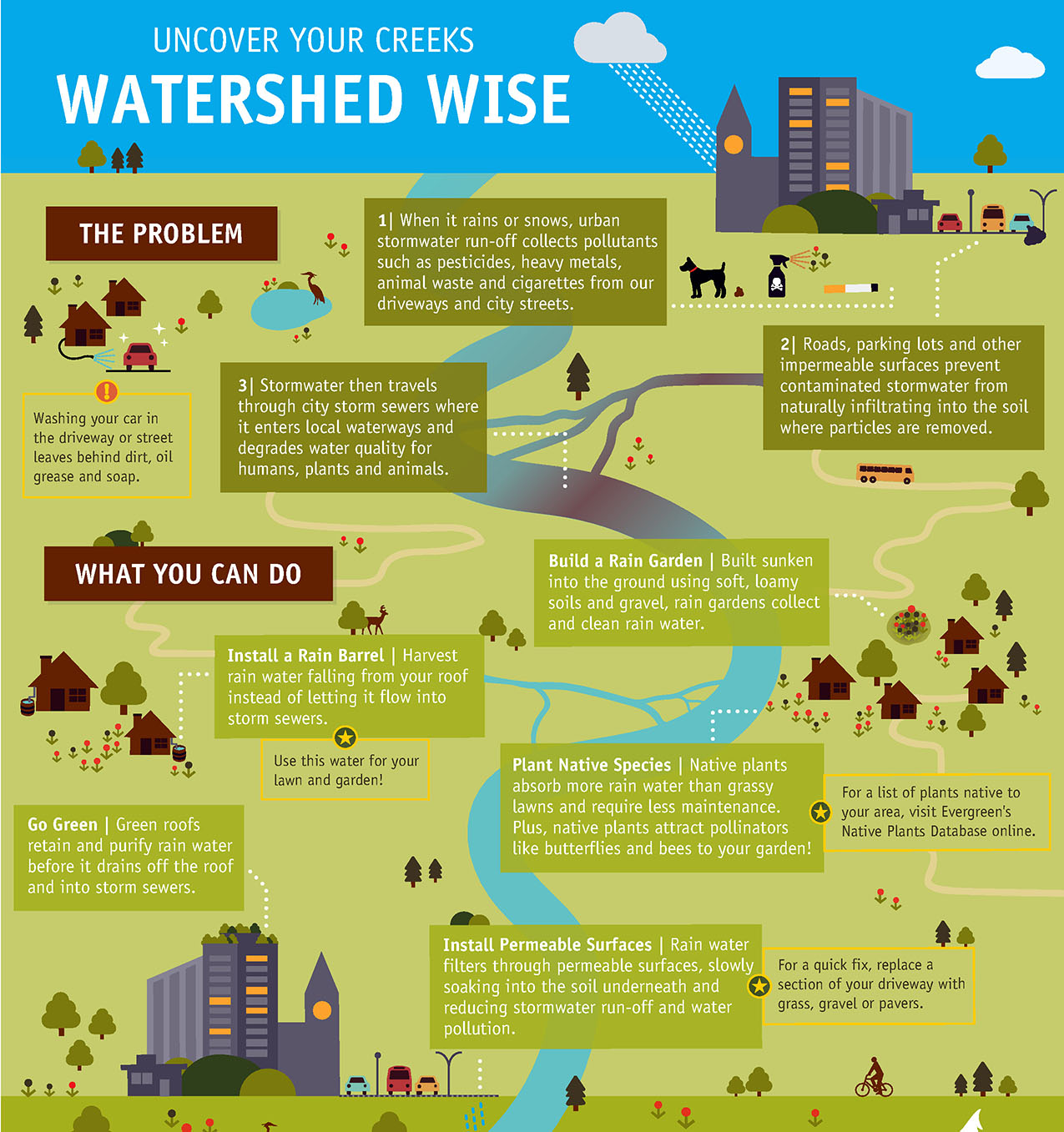Watershed Management
- 25 Oct 2021
- 9 min read
Overview
- Watershed:

- About: A watershed (also called drainage basin/catchment area) is an area of land that drains or “sheds” water into a specific waterbody.
- It is an independent drainage unit for surface water runoff.
- One watershed is separated from another by a natural boundary known as the water divide or the ridge line.
- Types of Watershed: They are classified depending upon the size, drainage, shape and land use pattern.
- Macro watershed (> 50,000 Ha)
- Sub-watershed (10,000 to 50,000 Ha)
- Milli-watershed (1000 to 10,000 Ha)
- Micro watershed (100 to 1000 Ha)
- Mini watershed (1-100 Ha)
- About: A watershed (also called drainage basin/catchment area) is an area of land that drains or “sheds” water into a specific waterbody.
- Watershed Management:
- About: It is the process of implementing land use practices and water management practices to protect and improve the quality of the water and other natural resources within a watershed.
- Objectives of Watershed Management:
- Pollution control
- Minimising over-exploitation of resources
- Water storage, flood control, checking sedimentation
- Wildlife preservation
- Erosion control and prevention of soil
- Recharging groundwater to provide regular water supply
- Components of Watershed Management Programmes:
- Soil and water conservation
- Plantation
- Agronomical practices
- Livestock management
- Renewable energy
- Institutional developments
Integrated Watershed Development Programme (IWMP)
- The Department of Land Resources, Ministry of Rural Development is implementing the Integrated Watershed Development Programme (IWMP) from 2009-10 with an objective to cover 55 million hectares of rain fed land by 2027.
- The IWMP is the second largest watershed programme in the world after China’s.
- It envisages restoring the ecological balance by harnessing, conserving and developing degraded natural resources such as soil, vegetative cover & water through watershed management initiatives.
- The program is being implemented in all the states of the country and is financed by the central and state governments in the ratio of 90:10.
- The outcomes of IWMP are prevention of soil run-off, regeneration of natural vegetation, rain water harvesting and recharging of the ground water table.
- This enables multi-cropping and the introduction of diverse agro-based activities, which help to provide sustainable livelihoods to the people residing in the watershed area.
- In 2015, the IWMP along with On-Farm Water Management (OFWM) scheme and Accelerated Irrigation Benefit Programme (AIBP) was subsumed into Pradhan Mantri Krishi Sinchayee Yojana (PMKSY).
- Other Initiatives Taken:
- Haryali is a watershed development project sponsored by the Central Government which aims at enabling the rural population to conserve water for drinking, irrigation, fisheries and afforestation.
- The Project is being executed by Gram Panchayats with people’s participation.
- Neeru-Meeru (Water and You) programme (in Andhra Pradesh) and Arvary Pani Sansad (in Alwar, Rajasthan) have taken up constructions of various water-harvesting structures such as percolation tanks, dug out ponds (Johad), check dams, etc., through people’s participation.
- Tamil Nadu has made water harvesting structures in the houses compulsory.
- No building can be constructed without making structures for water harvesting.
- Haryali is a watershed development project sponsored by the Central Government which aims at enabling the rural population to conserve water for drinking, irrigation, fisheries and afforestation.
Significance of Watershed Management
- Controls Pollution: Runoff from rainwater or snowmelt can contribute significant amounts of pollution into the lake or river.
- Watershed management helps to control pollution of the water and other natural resources in the watershed.
- Identifies and Regulates Ecologically Hazardous Activities: All activities that occur within a watershed somehow affect its natural resources and water quality.
- Watershed management planning comprehensively identifies such activities and makes recommendations to properly address them so that their adverse impacts can be reduced.
- Enhances Partnership Among the Stakeholders: Watershed management planning results in enhanced partnership among all the stakeholders in the watershed which is essential for the successful management of the land and water resources.
- It is also an efficient way to prioritize the implementation of watershed management plans in times when resources may be limited.
- Inclusive Growth: Inclusive growth refers to economic growth that is distributed fairly across society and creates opportunities for all. Watershed management is key for sustainable and inclusive growth.
- For instance, in drought-prone rainfed areas watershed management has shown the potential of doubling the agricultural productivity and assisting the rural families through increased water availability and diversifying the cropping and farming systems resulting in diversified sources of income.
Issues Faced by Watershed Management Programmes
- Project Related Issues: Factors such as outdated approaches, poor project design, inadequate and/or unsustained financial resources, very short time frames for project interventions and a lack of adequate understanding of the linkages between upland and lowland areas have contributed to under-achievement of watershed management programmes.
- Lack of Support from Legislations: Although broad environmental policies are in place in many countries, generally no attention is given to the development of watershed management policies.
- The lack or inadequate national policies, strategies and action plans are recognised as principal constraints to implementing sustainable watershed management programmes.
- Weak Institutional Base: Near-collapse of watershed-based institutions once these programmes are completed has been observed, as the inputs they received are often inadequate to sustain the institutional base.
- Similarly, Self Help Groups are not properly integrated into the watershed programmes.
- The nature of the institutional base influences the sustainability of the natural resources, ability of the communities to diversify and access support from different programmes.
- Programmes Non-Inclusive of Reserved Forestlands: Inclusion of reserve forestlands into watershed development plans and creation of entitlements over the forest produce is not yet a part of watershed development programmes.
- Absence of an agreement between forest department and rural development department on operational aspects is a critical bottleneck.
Way Forward
- Build Local Partnerships: Development of local partnerships leads to greater awareness and support from the general public.
- Aware individuals often become more involved in decision-making, protection and restoration efforts.
- Such involvement builds a sense of community, helps reduce conflicts and increases commitment to the actions necessary to meet environmental goals.
- Determine Priorities for Action: Watershed management planning should also determine what the opportunities are to reduce pollution or address other pressing environmental issues, prioritize those opportunities, and identify a time frame for accomplishing pollution reduction and resource and habitat improvements.
- Those issues that pose the greatest risk to human health or particular resources might be given the highest priority for control and reduction.
- Conduct Educational Programs: The degree of public education and participation in the planning process can greatly influence the success of watershed management.
- There are many ways to involve and educate the public in watershed management; formation of citizen review groups and advisory committees can gain public support from the watershed.
- Effective Implementation and Follow-Up: The watershed planning process should be implemented in a dynamic and adaptive manner.
- Long-term monitoring of watershed resources and their response to implementation actions identified in the plan is vital.

